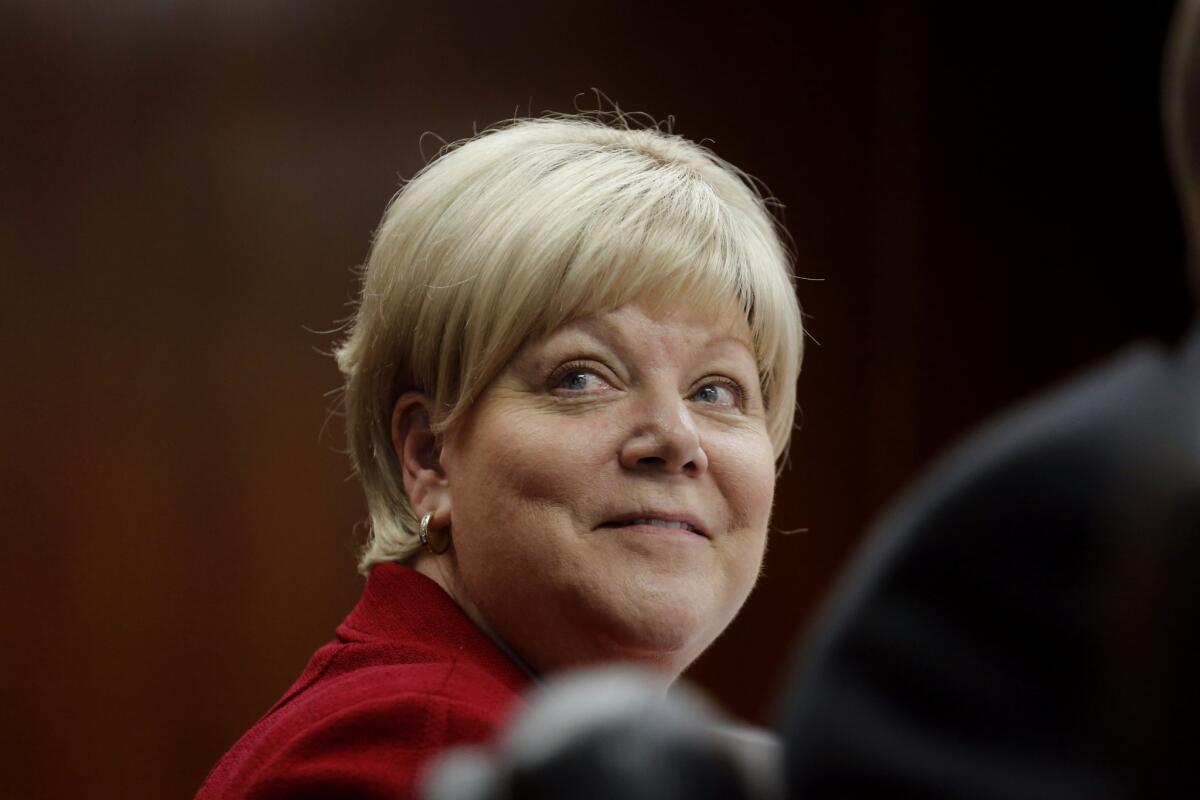DWP general manager continues pitch for hikes in water and power rates

LADWP General Manager Marcie L. Edwards presents her case for a rate increase July 08 at DWP headquarters.
- Share via
Eighteen months ago, Marcie Edwards became the first woman to lead the Los Angeles Department of Water and Power, the country’s largest publicly-owned utility, and it wouldn’t have happened without a stint as a “pit critter.”
Though she joined the DWP as a clerk-typist at age 19, Edwards soon found that as a woman, she could succeed in jobs on the operational side. She became a steam plant assistant, better known as a “pit critter.”
“They call it that because you work in the bowels of an electric generating station, monitoring the equipment and you are not allowed in the control room because you are a lower form of life,” Edwards, 58, said Wednesday at the City Club in downtown Los Angeles.
She was there to pitch the utility’s water and power rate increases to a group of civic and business leaders with Town Hall Los Angeles. But it was a question from a high school student, on whether to attend college or pursue a full-time job, that prompted Edwards to reflect on the way women approach challenges and specifically some of the dirtier jobs at the DWP.
“It just gave me such a leg up, but you have to believe you have the capability to do things you don’t know anything about and that’s hard for women,” she said.
By taking on the jobs traditionally held by men, Edwards said she was able to quadruple her pay and ultimately move up the management ladder. Now, as the head of the utility, it’s her job to win support for a proposal to hike water and power rates over the next five years. Her talk at the City Club was just one of the 40 community meetings the DWP has participated in as officials prepare to take their request to the Los Angeles City Council in December.
Under the proposal, the typical L.A. household would see its monthly bill increase from $132.44 to $156.17 at the end of five years. On the power side, the additional revenue would be used to help the DWP meet state mandates on renewable energy. On the water side, 85% of the new money would go to repair and replace an aging infrastructure.
“Infrastructure is not sexy. It’s not interesting. People don’t want to write articles on infrastructure,” Edwards said. “But it’s the most critical investment.”
To illustrate her point, Edwards showed the audience a photograph of a sinkhole that emerged after a water pipe burst under Sunset Boulevard last year, sending 20 million gallons of water onto the UCLA campus. Though that particular burst was spectacular enough to warrant live coverage by local television stations, the Department of Water and Power averages three to four water main breaks a day, Edwards said.
The water rate increase the DWP is seeking is separate from the rate adjustment approved last month in response to the drought. Because Angelenos did such a good job conserving water, the utility’s water revenues dropped. The Board of Water and Power Commissioners agreed to make the cost of water more expensive in response.
That situation shows that water agencies probably need to recalculate how they charge for water, Edwards said.
“The right way to do water is to charge for the infrastructure that you use and then you charge for the commodity you use and then if you save more, the commodity price goes down,” Edwards said.
The city’s independent ratepayer advocate is expected to release a report on the rate proposal next month. If the Los Angeles City Council ultimately approves the rate increases, they would take effect April 1, 2016.
For more news on California, follow @TheCityMaven.
More to Read
Sign up for Essential California
The most important California stories and recommendations in your inbox every morning.
You may occasionally receive promotional content from the Los Angeles Times.











